Title
Preface
Table of Contents
Introduction
Speeding Learning
Speeding Learning
Regularization Techniques to Improve Generalization
Efficient BackProp
Introduction
Learning and Generalization
Standard Backpropagation
A Few Practical Tricks
Stochastic versus Batch Learning
Shuffling the Examples
Normalizing the Inputs
The Sigmoid
Choosing Target Values
Initializing the Weights
Choosing Learning Rates
Radial Basis Functions vs Sigmoid Units
Convergence of Gradient Descent
A Little Theory
Examples
Input Transformations and Error Surface Transformations Revisited
Classical Second Order Optimization Methods
Newton Algorithm
Conjugate Gradient
Quasi-Newton (BFGS)
Gauss-Newton and Levenberg Marquardt
Tricks to Compute the Hessian Information in Multilayer Networks
Finite Difference
Square Jacobian Approximation for the Gauss-Newton and Levenberg-Marquardt Algorithms
Backpropagating Second Derivatives
Backpropagating the Diagonal Hessian in Neural Nets
Computing the Product of the Hessian and a Vector
Analysis of the Hessian in Multi-layer Networks
Applying Second Order Methods to Multilayer Networks
A Stochastic Diagonal Levenberg Marquardt Method
Computing the Principal Eigenvalue/Vector of the Hessian
Discussion and Conclusion
References
Regularization Techniques to Improve Generalization
Early Stopping — But When?
Early Stopping Is Not Quite as Simple
Why Early Stopping?
The Basic Early Stopping Technique
The Uglyness of Reality
How to Do Early Stopping Best
Some Classes of Stopping Criteria
The Trick: Criterion Selection Rules
Where and How Well Does This Trick Work?
Concrete Questions
Experimental Setup
Experiment Results
Discussion: Answers to the Questions
Generalization of These Results
Why This Works
References
A Simple Trick for Estimating the Weight Decay
Parameter
Introduction
Ill-Posed Problems, Regularization, and Such Things...
Ill-Posed Problems
Regularization
Bias and Variance
Bayesian Framework
Weight Decay
Early Stopping
Estimating
Search Estimates
Two Early Stopping Estimates
Experiments
Data Sets
Experimental Procedure
Quality of the Estimates
Weight Decay versus Early Stopping Committees
Conclusions
References
Controlling the Hyperparameter Search in
MacKay’s Bayesian Neural Network Framework
Introduction
Hyperparameter Updates
Difficulties with Using the Update Formulas
Control Strategies
Choosing When to Update Hyperparameters
Dealing with Out-of-Bounds Estimates of Numbers of Well-Determined Parameters
Further Generally Applicable Strategies
Experimental Setup
Targets for ``Good'' Performance
Network Architecture and Training
Effectiveness of Control Strategies
Relationship of Test Set Error to Evidence
Conclusion
References
Adaptive Regularization in Neural Network Modeling
Introduction
Training and Generalization
Adapting Regularization Parameters
Numerical Experiments
Potentials and Limitations in the Approach
Classification
Time Series Prediction
Conclusions
References
Large Ensemble Averaging
Introduction
Extrapolation to Large-Ensemble Averages
Application to the Sunspots Problem
Best Result
Theoretical Analysis
References
Improving Network Models and Algorithmic Tricks
Improving Network Models and Algorithmic Tricks
Square Unit Augmented, Radially Extended, Multilayer Perceptrons
Introduction and Motivation
The Trick: A SQUARE-MLP
Example Applications
Hill-Plateau Function Approximation
Two-Spirals Classification
Vowel Classification
Theoretical Justification
Intuitive and Topological Justification
Conclusions
References
A Dozen Tricks with Multitask Learning
Introduction to Multitask Learning in Backprop Nets
Single and Multitask Learning of Task 1
Results
Discussion
Tricks for Using Multitask Learning in the Real World
Using the Future to Predict the Present
Multiple Metrics
Multiple Output Representations
Time Series Prediction
Using Non-operational Features
Using Extra Tasks to Focus Attention
Hints: Tasks Hand-Crafted by a Domain Expert
Handling other Categories in Classification
Sequential Transfer
Similar Tasks With Different Data Distributions
Learning with Hierarchical Data
Some Inputs Work Better as Outputs
Getting the Most Out of MTL
Use Large Hidden Layers
Do Early Stopping for Each Task Separately
Use Different Learning Rates for Different Tasks
Use a Private Hidden Layer for the Main Task
Chapter Summary
References
Solving the Ill-Conditioning in Neural Network Learning
Introduction
The Learning Process
Learning Methodology
Condition of the Learning Problem
What Causes the Singularities
Definition of Minimum
Local Minima are Caused by BackPropagation
A New Neural Network Structure
Influence on the Approximation Error E
M and the Universal Approximation Theorems
Example
Applications
Conclusion
References
Centering Neural Network Gradient Factors
Introduction
Centered Backpropagation
Activity Propagation
Weight Modification
Error Backpropagation
Implementation Techniques
A Priori Methods
Adaptive Methods
Empirical Results
Setup of Experiments
Symmetry Detection Problem
Vowel Recognition Problem
Discussion
References
Avoiding Roundoff Error in Backpropagating Derivatives
Introduction
Roundoff Error in Sigmoid Units
Sum-Squared Error Computations
Single Logistic-Output Cross-Entropy Computations
Other Approaches to Avoiding Zero-Derivatives with the Logistic Function
Softmax and Cross-Entropy Computations
Roundoff Error in Tanh Units
Why Bother?
References
Representing and Incorporating Prior Knowledge in
Neural Network Training
Representing and Incorporating Prior Knowledge in Neural Network Training
Transformation Invariance in Pattern Recognition– Tangent Distance and Tangent Propagation
Introduction
Memory Based Algorithms
Learned-Function Algorithms
Tangent Distance
Implementation
Some Illustrative Results
How to Make Tangent Distance Work
Tangent Propagation
Local Rule
Results
How to Make Tangent Prop Work
Tangent Vectors
Lie Groups and Lie Algebras
Tangent Vectors
Important Transformations in Image Processing
Conclusion
References
Combining Neural Networks and Context-Driven Search for On-line, Printed Handwriting
Recognition in the Newton
Introduction
System Overview
Tentative Segmentation
Character Classification
Representation
Architecture
Normalizing Output Error
Negative Training
Stroke Warping
Frequency Balancing
Error Emphasis
Annealing
Quantized Weights
Context-Driven Search
Lexical Context
Geometric Context
Integration with Word Segmentation
Discussion
Future Extensions
References
Neural Network Classification and Prior Class
Probabilities
Introduction
The Trick
Prior Scaling
Probabilistic Sampling
Post Scaling
Equalizing Class Membership
Experimental Results
Performance Measures
ECG Classification Problem
Explanation
Convergence and Representation Issues
Overlapping Distributions
Limitations
A Posteriori Proofs
Conclusions
References
Applying Divide and Conquer to Large Scale
Pattern Recognition Tasks
Introduction
Hierarchical Classification
Decomposition of Posterior Probabilities
Hierarchical Interpretation
Estimation of Conditional Node Posteriors
Classifier Tree Design
Optimality
Prior Knowledge
Confusion Matrices
Agglomerative Clustering
Application to Speech Recognition
Statistical Speech Recognition
Emission and Transition Modeling
Phonetic Context Modeling
Connectionist Acoustic Modeling
ACID Clustering
Training Hierarchies of Neural Networks on Large Datasets
Conclusions
References
Tricks for Time Series
Tricks for Time Series
Forecasting the Economy with Neural Nets: A Survey of Challenges and Solutions
Challenges of Macroeconomic Forecasting
A Survey of Neural Network Solutions
Smoothing Regularizers for Better Generalization
Model Selection and Interpretation
Improving Forecasts via Architecture and Input Selection
Architecture Selection via the Prediction Risk
Estimation of Prediction Risk
Algebraic Estimates of Prediction Risk
NCV: Cross-Validation for Nonlinear Models
Pruning Inputs via Directed Search and Sensitivity Analysis
Empirical Example
Gaining Economic Understanding through Model Visualization
Discussion
References
How to Train Neural Networks
Introduction
Preprocessing
Architectures
Net Internal Preprocessing by a Diagonal Connector
Net Internal Preprocessing by a Bottleneck Network
Squared Inputs
Interaction Layer
Averaging
Regularization by Random Targets
An Integrated Network Architecture for Forecasting Problems
Cost Functions
Robust Estimation with LnCosh
Robust Estimation with CDEN
Error Bar Estimation with CDEN
Data Meets Structure
The Observer-Observation Dilemma
Learning Reviewed
Parameter Noise as an Implicit Penalty Function
Cleaning Reviewed
Data Noise Reviewed
Cleaning with Noise
A Unifying Approach: The Separation of Structure and Noise
Architectural Optimization
Node-Pruning
Weight-Pruning
The Training Procedure
Training Paradigms: Early vs. Late Stopping
Setup Steps
Learning: Generation of Structural Hypothesis
Pruning: Falsification of the generated Structure
Final Stopping Criteria of the Training
Diagram of the Training Procedure
Experiments
Conclusion
References
Big Learning in Deep Neural Networks
Big Learning and Deep Neural Networks
Stochastic Gradient Descent Tricks
Introduction
What Is Stochastic Gradient Descent?
Gradient Descent
Stochastic Gradient Descent
The Convergence of Stochastic Gradient Descent
When to Use Stochastic Gradient Descent?
The Trade-Offs of Large Scale Learning
Asymptotic Analysis of the Large-Scale Case
General Recommendations
Preparing the Data
Monitoring and Debugging
Linear Models with L2 Regularization
Sparsity
Learning Rates
Averaged Stochastic Gradient Descent
Experiments
Conclusion
References
Practical Recommendations for Gradient-Based Training of Deep Architectures
Introduction
Deep Learning and Greedy Layer-Wise Pretraining
Denoising and Contractive Auto-encoders
Online Learning and Optimization of Generalization Error
Gradients
Gradient Descent and Learning Rate
Gradient Computation and Automatic Differentiation
Hyper-parameters
Neural Network Hyper-parameters
Hyper-parameters of the Model and Training Criterion
Manual Search and Grid Search
Random Sampling of Hyper-parameters
Debugging and Analysis
Gradient Checking and Controlled Overfitting
Visualizations and Statistics
Other Recommendations
Multi-core Machines, BLAS and GPUs
Sparse High-Dimensional Inputs
Symbolic Variables, Embeddings, Multi-task Learning and Multi-relational Learning
Open Questions
On the Added Difficulty of Training Deeper Architectures
Adaptive Learning Rates and Second-Order Methods
Conclusion
References
Training Deep and Recurrent Networks with Hessian-Free Optimization
Introduction
Feedforward Neural Networks
Recurrent Neural Networks
Hessian-Free Optimization Basics
Exact Multiplication by the Hessian
The Generalized Gauss-Newton Matrix
Multiplying by the Gauss-Newton Matrix
Typical Losses
Dealing with Non-convex Losses
Implementation Details
Efficiency via Parallelism
Verifying the Correctness of G Products
Damping
Tikhonov Damping
Problems with Tikhonov Damping
Scale-Sensitive Damping
Structural Damping
The Levenberg-Marquardt Heuristic
Trust-Region Methods
CG Truncation as Damping
Line Searching
Convergence of CG
Initializing CG
Preconditioning
The Effects of Preconditioning
Designing a Good Preconditioner
The Empirical Fisher Diagonal
An Unbiased Estimator for the Diagonal of G
Minibatching
Higher Quality Gradient Estimates
Minibatch Overfitting and Methods to Combat It
Tricks and Recipes
Summary
References
Implementing Neural Networks Efficiently
Efficient Environment
Scripting Language
Multi-purpose Efficient N-Dimensional Tensor Object
Modular Neural Networks
Additional Torch7 Packages
Efficient Runtime Execution
Float or Double Representations
Memory Allocation Control
BLAS/LAPACK Interfaces
SIMD Instructions
Ordering Memory Accesses
OpenMP Support
CUDA Support
Benchmarks
Efficient Optimization Heuristics
Conclusion
References
Better Representations: Invariant, Disentangled and
Reusable
Better Representations: Invariant, Disentangled
and Reusable
Learning Feature Representations with K-Means
Introduction
Data, Pre-processing and Initialization
Pre-processing
Initialization
Comparison to Sparse Feature Learning
Application to Image Recognition
Parameters
Encoders
Local Receptive Fields and Multiple Layers
Deep Networks
Conclusion
References
Deep Big Multilayer Perceptrons for Digit
Recognition
Introduction
Data
Architectures
Deforming Images to Get More Training Instances
Forming a Committee
Using the GPU to Train Deep MLPs
Single MLP
Committee of MLP
Discussion
References
A Practical Guide to Training Restricted
Boltzmann Machines
Introduction
An Overview of Restricted Boltzmann Machines and Contrastive Divergence
How to Collect Statistics When Using Contrastive Divergence
Updating the Hidden States
Updating the Visible States
Collecting the Statistics Needed for Learning
A Recipe for Getting the Learning Signal for CD1
The Size of a Mini-batch
A Recipe for Dividing the Training Set into Mini-batches
Monitoring the Progress of Learning
A Recipe for Using the Reconstruction Error
Monitoring the Overfitting
A Recipe for Monitoring the Overfitting
The Learning Rate
A Recipe for Setting the Learning Rates for Weights and Biases
The Initial Values of the Weights and Biases
A Recipe for Setting the Initial Values of the Weights and Biases
Momentum
A Recipe for Using Momentum
Weight-Decay
A Recipe for Using Weight-Decay
Encouraging Sparse Hidden Activities
A Recipe for Sparsity
The Number of Hidden Units
A Recipe for Choosing the Number of Hidden Units
Different Types of Unit
Softmax and Multinomial Units
Gaussian Visible Units
Gaussian Visible and Hidden Units
Binomial Units
Rectified Linear Units
Varieties of Contrastive Divergence
Displaying What Is Happening during Learning
Using RBM's for Discrimination
Computing the Free Energy of a Visible Vector
Dealing with Missing Values
References
Deep Boltzmann Machines and the Centering
Trick
Introduction
Boltzmann Machines
Deep Boltzmann Machines
Training Boltzmann Machines
The Centering Trick
Understanding the Centering Trick
Evaluating Boltzmann Machines
Discriminative Analysis
Generative Analysis
Experiments
Conclusion
References
Deep Learning via Semi-supervised Embedding
Introduction
Semi-supervised Embedding
Embedding Algorithms
Semi-supervised Algorithms
Semi-supervised Embedding for Deep Learning
Labeling Unlabeled Data as Neighbors (Building the Graph)
When Do We Expect This Approach to Work?
Why Is This Approach Good?
Experimental Evaluation
Small-Scale Experiments
MNIST Experiments
Deeper MNIST Experiments
Semantic Role Labeling
Object Recognition Using Unlabeled Video
Conclusion
References
Identifying Dynamical Systems for Forecasting and
Control
Identifying Dynamical Systems for Forecasting
and Control
A Practical Guide to Applying
Echo State Networks
Introduction
The Basic Model
Producing a Reservoir
Function of the Reservoir
Global Parameters of the Reservoir
Practical Approach to Reservoir Production
Pointers to Reservoir Extensions
Training Readouts
Ridge Regression
Regularization
Large Datasets
Direct Pseudoinverse Solution
Initial Transient
Regression Weighting
Readouts for Classification
Online Learning
Pointers to Readouts Extensions
Dealing with Output Feedbacks
Output Feedbacks
Teacher Forcing
Online Learning with Real Feedbacks
Summary and Implementations
References
Forecasting with Recurrent Neural Networks:
12 Tricks
Introduction
Tricks for Recurrent Neural Networks
Conclusion and Outlook
References
Solving Partially Observable Reinforcement
Learning Problems with Recurrent Neural Networks
Introduction
Background
The Trick of Modeling a Markovian State Space Using a Recurrent Neural Network
Improving the Generalization Capabilities with Respect to Actions
A Recipe to Improve the Modeling of State Transitions
Scaling of Inputs and Targets
Block Validation
Removal of Invalid Data Patterns
Learning Settings
Double Rest Learning
A Recipe to Generate an Efficient State Estimation Function
Application of a Neural State Estimator
The Markov Decision Process Extraction Network
Reward Function Design Influences the Performance of a State Estimator
Choosing the Forecast Horizon of a State Estimator
The Trick of Addressing Long Term Dependencies
A Recipe to Find a Good Shortcut Length
Experiments on Long Term Dependencies Problems
Conclusion
References
10 Steps and Some Tricks to Set up Neural
Reinforcement Controllers
Overview
The Reinforcement Learning Framework
Learning in Markovian Decision Processes
Q-Learning with Function Approximation
Characteristics of the Control Task
Modeling the Learning Task
State Information
Actions
Choice of Control Interval t
The Terminal Goal State and The Non-terminal Goal State Setting
Choice of X+
Choice of X-
Choice of Immediate and Final Costs
Discounting
Choice of X0
Choice of the Maximal Episode Length N
Tricks
Scaling the Input Values
The X++-Trick
Artificial Training Transitions
Growing Batch
Training the Neural Q-Function
Exploration
Delays
Experiments
The Control Task
Modeling as a Learning Task
Applied Tricks
Measuring Quality
Results on the Simulated Cart Pole
Results on the Real Cart Pole
Conclusion
References
Author Index
Subject Index
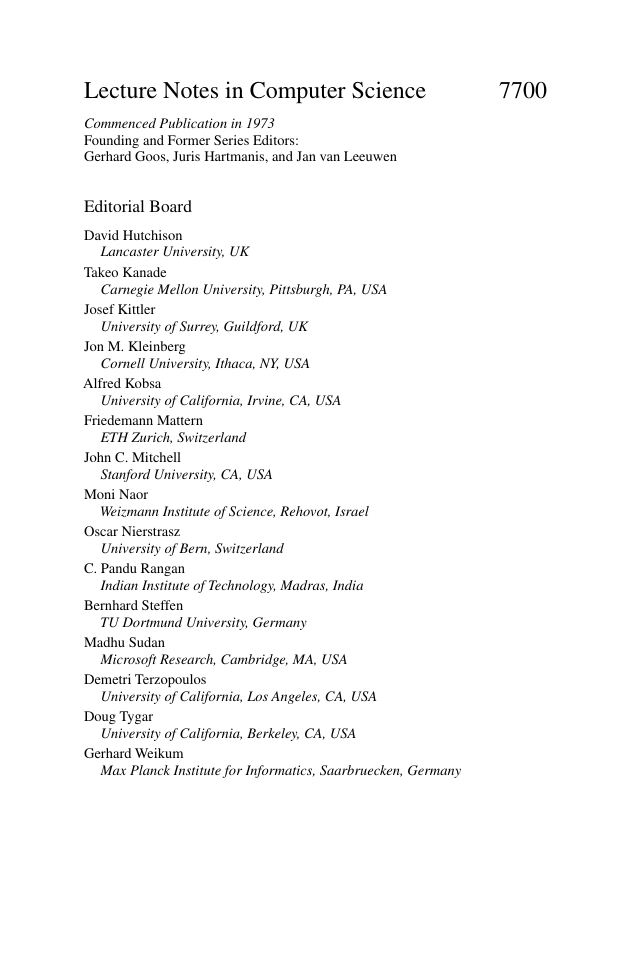
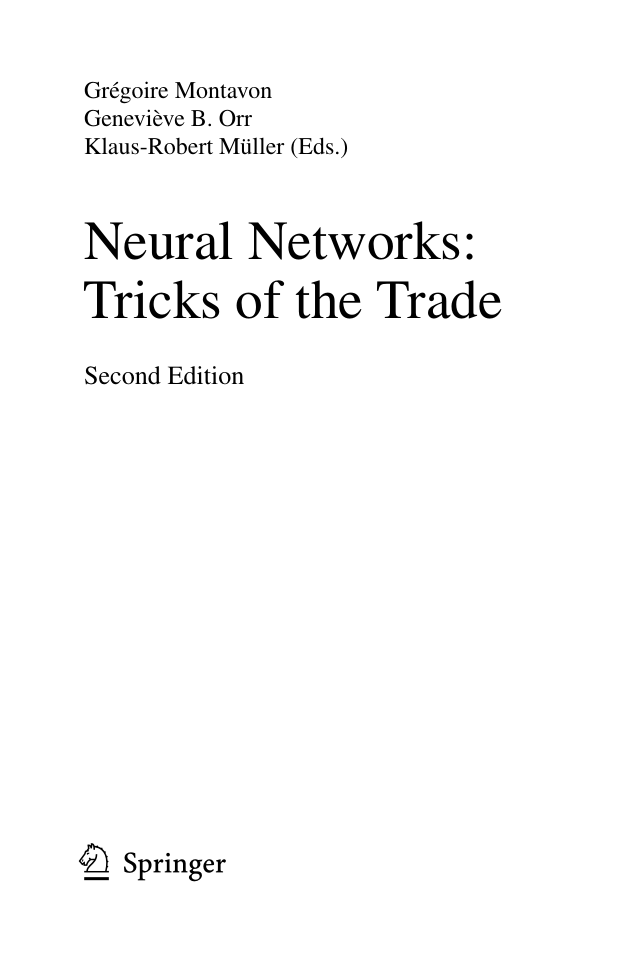

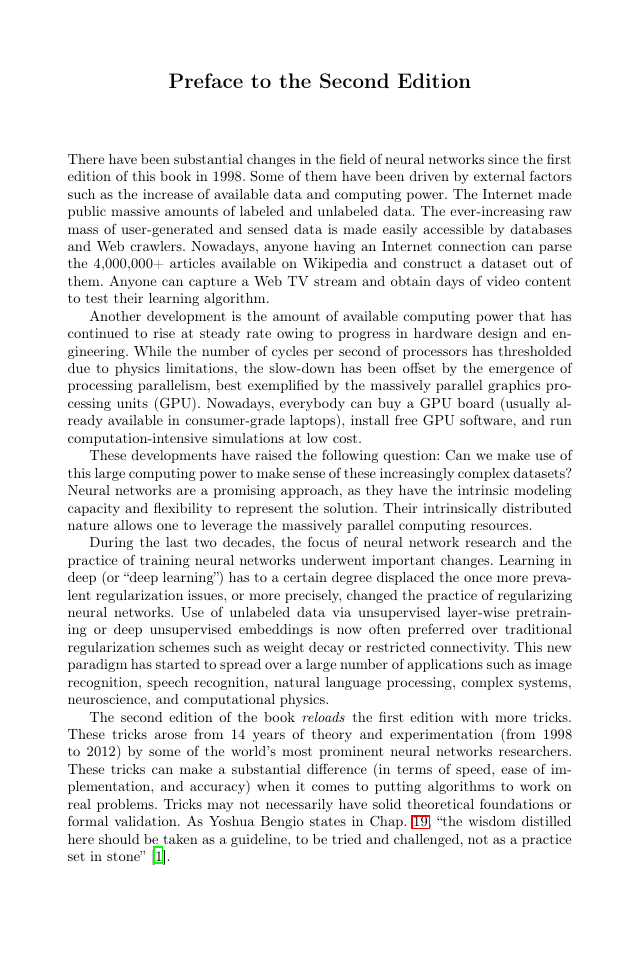
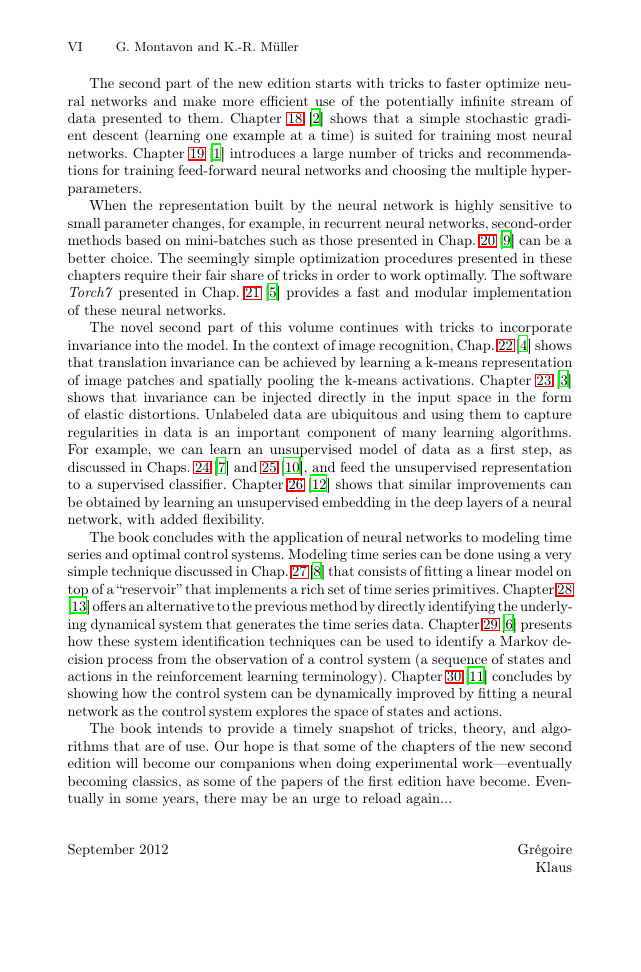
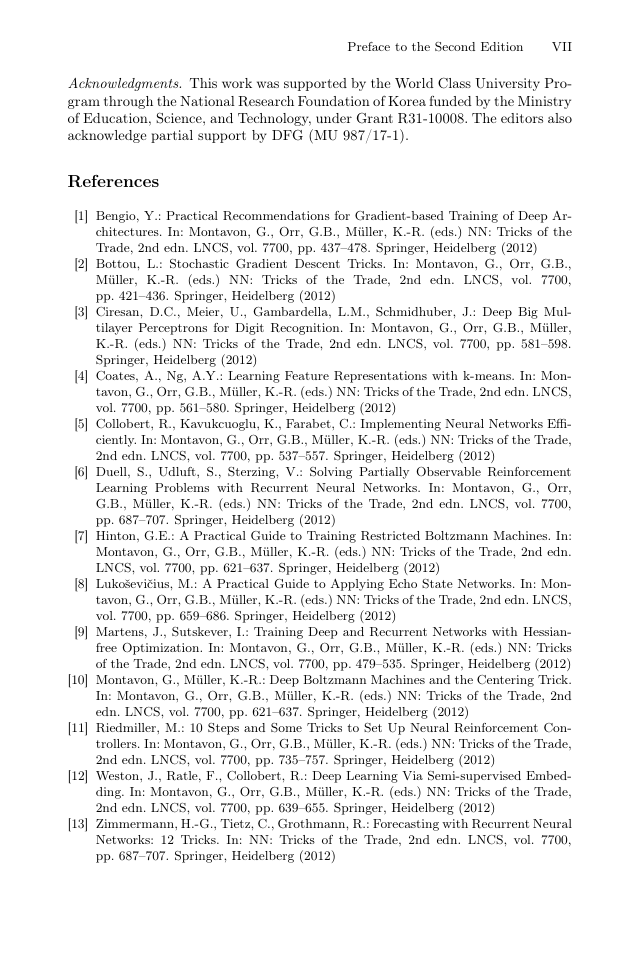
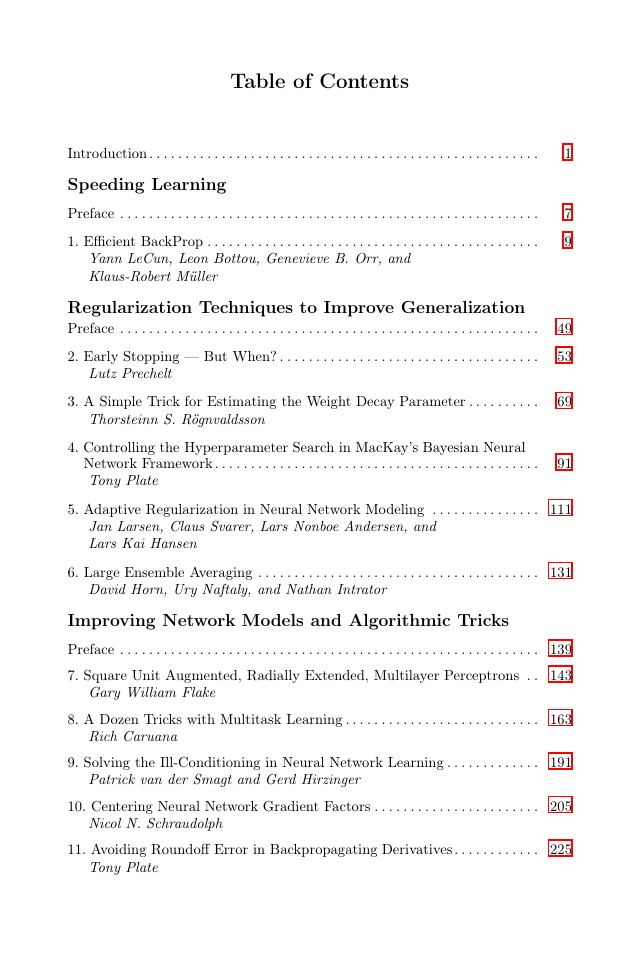
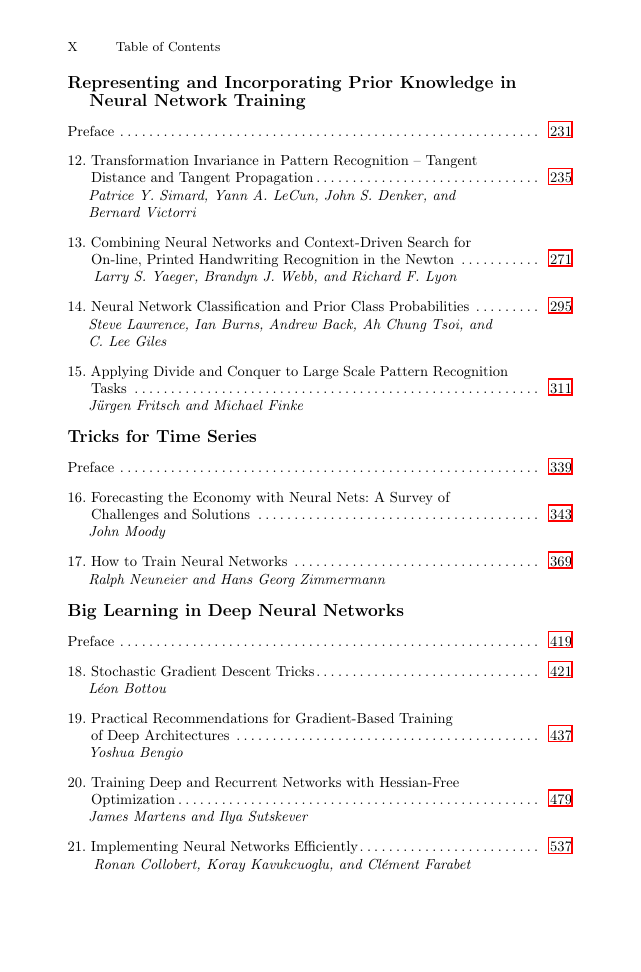








 2023年江西萍乡中考道德与法治真题及答案.doc
2023年江西萍乡中考道德与法治真题及答案.doc 2012年重庆南川中考生物真题及答案.doc
2012年重庆南川中考生物真题及答案.doc 2013年江西师范大学地理学综合及文艺理论基础考研真题.doc
2013年江西师范大学地理学综合及文艺理论基础考研真题.doc 2020年四川甘孜小升初语文真题及答案I卷.doc
2020年四川甘孜小升初语文真题及答案I卷.doc 2020年注册岩土工程师专业基础考试真题及答案.doc
2020年注册岩土工程师专业基础考试真题及答案.doc 2023-2024学年福建省厦门市九年级上学期数学月考试题及答案.doc
2023-2024学年福建省厦门市九年级上学期数学月考试题及答案.doc 2021-2022学年辽宁省沈阳市大东区九年级上学期语文期末试题及答案.doc
2021-2022学年辽宁省沈阳市大东区九年级上学期语文期末试题及答案.doc 2022-2023学年北京东城区初三第一学期物理期末试卷及答案.doc
2022-2023学年北京东城区初三第一学期物理期末试卷及答案.doc 2018上半年江西教师资格初中地理学科知识与教学能力真题及答案.doc
2018上半年江西教师资格初中地理学科知识与教学能力真题及答案.doc 2012年河北国家公务员申论考试真题及答案-省级.doc
2012年河北国家公务员申论考试真题及答案-省级.doc 2020-2021学年江苏省扬州市江都区邵樊片九年级上学期数学第一次质量检测试题及答案.doc
2020-2021学年江苏省扬州市江都区邵樊片九年级上学期数学第一次质量检测试题及答案.doc 2022下半年黑龙江教师资格证中学综合素质真题及答案.doc
2022下半年黑龙江教师资格证中学综合素质真题及答案.doc